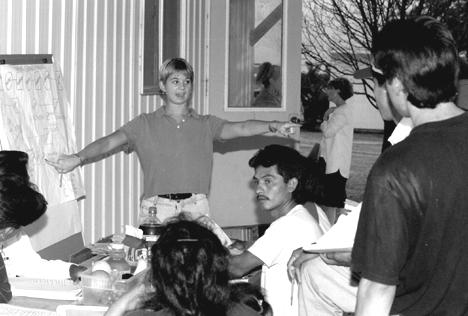The University Record, September 3, 1997
|
|
Betsy Shields teaches the words for groceries and coins. Photo by Bob Kalmbach |
By Deborah Gilbert
News and Information Services
Mexican migrant workers who labor long, steamy hours in the flat cucumber and pepper fields outside of Adrian gathered around outdoor picnic tables once and sometimes twice a week this summer to learn “Survival English” from nine juniors and seniors. Michigan, which draws about 45,000 migrant workers to the state annually, is second only to California in the use of migrant labor.
“Today we are going to talk about going to the doctor and we will learn some new questions. The questions are, ‘What’s wrong?’ and ‘What hurts?'” says Chiara Libertore, an LSA senior, as she touches her head during a lesson on parts of the body.
Thirty feet away at another picnic table, LSA seniors Betsy Shields and Jennifer Barker pull soda pop, plastic grapes and different coins out of a box, ready to coach the workers on English words for specific groceries and coins.
The three were applying methods they learned in their rigorous but absorbing teacher training program in May and June.
Survival English, they learned, zeroes in on exactly what migrant workers say they need to know to get by-life skills such as filling out job applications, opening a bank account, applying for a driver’s license, dealing with car maintenance problems, buying groceries, getting correct change, obtaining a GED, mastering citizenship questions for future naturalization, explaining symptoms to physicians, calling 911 and learning basic grammar.
“Teaching at the beginner’s level requires careful self-monitoring,” explained John M. Swales, director of the English Language Institute (ELI), in a June training class. “Speak clearly at a reasonable pace and be careful about your word choice and syntax. Repeat and re-phrase and don’t try to do too much at once. And use authentic materials the workers care about,” he told them, pulling bright, easy-to-read grocery coupons out of a sack, along with copies of driver’s training handbooks and classified ads for cars.
The U-M students receive five academic credits in the linguistics or American culture programs for their efforts, but the evening classes, which took place in three camps, are clearly more pleasure than work for both the teachers and migrant workers.
“It is no struggle to get the migrant workers involved,” says Pilar S. Anadon, assistant editor in Marketing Communications and a 1995 U-M graduate in English. Anadon is co-coordinating the project this year with Victoria E. Clark, ELI research assistant and 1966 U-M graduate in linguistics.
“Even though they work incredibly hard all day, the workers seem really glad to come to class. They are tireless, and the two-hour classes often run overtime,” Clark says.
Obstacles abound, of course. The migrant workers don’t use much English during the work day, they have limited experience in a classroom setting and, all too often, have had few positive experiences speaking English in the past.
“But all that doesn’t stop them,” Anadon says. “The workers are still highly motivated because learning English can help them with policemen, doctors and employers and in social encounters.”
“I was so inspired by the workers’ enthusiasm that I am organizing a class for the many restaurant workers in this area who cannot speak English,” Shields adds, noting that the summer has been a “great experience.”
The U-M project was triggered by an e-mail message sent in the spring 1996 by Maria Arellano, a former migrant worker who is now a social worker for Lenawee County. Arellano explained that due to state budget cuts in adult education, the English as a Second Language Program in Lenawee County had been eliminated and they were desperate for help. Patricia M. Aldridge, assistant librarian at the ELI, forwarded the message in a mass e-mail to groups throughout the University, and Anadon, Clark, and about 10 other volunteers answered the call, learning how to teach as they went along.
In spring 1997, however, Anadon and Clark solicited and received training and financial help from LSA, the Office of the Provost for Academic and Multicultural Affairs, ELI, and the Center for Learning through Community Service. Also, English Lecturer Carolyn Madden became their faculty adviser.
“The program’s educational and social value for the U-M students as well as the migrant workers was exciting and obvious,” says Lincoln B. Faller, LSA dean for undergraduate education. “And it is important to note that Anadon’s and Clark’s proposal came out of volunteer work done by Michigan students in 1996, so the idealism was tempered with real experience.
“The program’s integration of classroom work, where the students get their teacher training, with actual practice in the real world is wholly congruent with a number of other community service learning initiatives at U-M,” Faller adds. “I have been very impressed by my conversations with everyone involved-by their commitment, their energy, their readiness to work productively together as well as their realistic sense of what they can achieve. It is a fine example of the power of real-world learning f or undergraduates.”
“We hope the course will continue and grow. We worked in three camps this summer and hope to cover more camps in both Lenawee and Washtenaw County next year,” Clark said.


